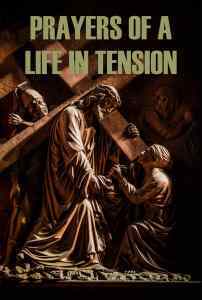Stephen W. Hiemstra's Blog, page 251
February 1, 2016
3 Reasons that Christian Apologetics and Spirituality Should not be Separated

Art by Stephen W. Hiemstra
By Stephen W. Hiemstra
Interviewers love experts. Specialists dominate public discourse. Problems arise when one field depends heavily on another and experts have to depart from their expertise. The fields of Christian apologetics and spirituality suffer from this problem.
Christian apologetics focuses on defending the truth claims of Christianity while spirituality focuses on living them out. Balance between these two fields is clearly needed in a world of imperfect information because learning more about the truth claims of Christianity informs how they are lived out and vice versa. Thus, treating either field independently of the other renders the spirituality dead and the apologetics impractical.
At least three reasons can be cited for why apologetics and spirituality should be closely linked.
The first reason for unity of apologetics and spirituality arises in the context of the apologist’s favorite Bible verse fragment:
“…always being prepared to make a defense to anyone who asks you for a reason for the hope that is in you…” (1 Peter 3:15 ESV)
The context of this fragment—in fact, the entire book of 1 Peter—is one of “lifestyle evangelism” in the midst of persecution. For example, we read:
“Now who is there to harm you if you are zealous for what is good? But even if you should suffer for righteousness’ sake, you will be blessed. Have no fear of them, nor be troubled, but in your hearts honor Christ the Lord as holy … [fragment] … having a good conscience, so that, when you are slandered, those who revile your good behavior in Christ may be put to shame.” (1 Peter 3:13-16)
In other words, the Apostle Peter says to shame your tormentors with your godly lifestyle! We to offer a verbal defense only in the context of an authentic Christian lifestyle (spirituality).
The second reason for unity of apologetics and spirituality arises because their separation affects a division between heart (spirituality) and mind (apologetics)—an example of Greek dualism. The Bible teaches that heart and mind cannot be separated, in part, because God created them both just like God created the earth and heaven (Genesis 1:1). Jesus’ bodily resurrection also speaks to the unity of the body (heart) and spirit (mind; e.g. Luke 24:36-43).
The need for unity of heart and mind has been debated throughout church history. For example, Pastor and theologian Jonathan Edwards (2009, 13)—when writing in 1746 about the effects of the Great Awakening—noted that both head and heart were necessary for effective discipling. More recently, Matthew Elliott has argued that God of the Bible is an emotionally stable deity and consistently expresses emotions in keeping with his character. This is unlike other deities in the ancient world who were typically characterized as selfish and capacious in dealing with humans. In other words, God displays emotions consistent with his thinking more frequently than we do with ours!
The third reason for unity of apologetics and spirituality arises from the observation that separation leads to serious lifestyle problems. If our spirituality is not informed by our thinking, then we will be more likely to act solely on emotions—doing what feels good.
Working as a chaplain intern in a Washington hospital in 2011 and 2012, I noticed a disturbing trend among patients. More than half of all patients admitted to the emergency room had problems stemming from relational problems and poor life-style choices. Overweight patients came in with diabetes, asthma, joint problems, and cardiac problems. Men passed out on the street from excessive drinking or other drug abuses. Young men and women fearful of contracting AIDS came in to be tested. These trends were even more pronounced among psyche patients.
We should expect these patient outcomes—doing what feels good comes naturally. The standard behavioral learning model teaches that even an amoeba will response to a positive stimulus by repeating the behavior that evoked the positive stimulus and doing less of the behavior associated with a negative stimulus. When the standard behavioral model breaks down, as it does in most moral dilemmas, then disaster directly follows. For example, this is the story of many addictions. In this respect, the Apostle Paul lamented: “For I have the desire to do what is right, but not the ability to carry it out” (Romans 7:18).
Knowing that apologetics and spirituality inform each other, are treated as part of a unified whole in the Bible, and serve to strengthen our moral resolve in a world of temptations, Christians and theologians need to reflect on how this integration of heart and mind can be strengthened both in theory and in practice. Let’s start today.
References
Chan, Simon.1998. Spiritual Theology: A Systematic Study of the Christian Life. Downers Grove: IVP Academic.
Cross, John G. and Melvin J. Guyer. 1980. Social Traps. Ann Arbor: University of Michigan Press.
Edwards, Jonathan. 2009. The Religious Affections (orig pub 1746). Vancouver: Eremitical Press.
Elliott, Matthew A. 2006. Faithful Feelings: Rethinking Emotion in the New Testament. Grand Rapids: Kregel Academic and Professional.
Sproul, R.C. 2003. Defending Your Faith: An Introduction to Apologetics. Wheaton: Crossway Books.
“The term apologetics comes from the Greek word apologia, which literally means ‘a reasoned statement or a verbal defense.’” (Sproul 203,13).
“Generally,spirituality refers to the kind of life that is formed by a particular type of spiritual theology. Spirituality is the lived reality, whereas spiritual theology is the systematic reflection and formalization of that reality.” (Chan 1998,16).
Elliott distinguishes 2 theories of emotions: the cognitive theory and the non-cognitive theory. The cognitive theory of emotions argues that “reason and emotion are interdependent” (47) while the non-cognitive theories promote the separation of reason and emotion (46). In other words, the cognitive theory states that we get emotional about the things that we believe strongly. Our emotions are neither random nor unexplained—they are not mere physiology. Elliott writes: “if the cognitive theory is correct, emotions become an integral part of our reason and our ethics” (53-54) informing and reinforcing moral behavior. Review at: (http://wp.me/p3Xeut-1dc).
Speaking later with the head surgeon, he corrected my observation. He reported that not half the patients but three-quarters of them were admitted with relational problems and poor lifestyle choices.
Behavioral psychologists are well aware of this moral dilemma. See, for example, Cross and Guyer (1980). Review at: (http://wp.me/p3Xeut-Zp).
January 31, 2016
14. Prayers of a Life in Tension by Stephen W. Hiemstra
I praise you for your enduring presence in my life.
Your glory surrounds me.
It wakes me in the morning, its spirits my day, it protects me during the night.
Empty me of all bitterness, all dispair, all feelings that deflate my life.
Help me to confess my weaknesses, my brokenness, my sin.
To make room for your glory, your mercy, your love.
Heal me in your presence when only your presence will do.
Bind up my wounds, give a hope, guide me in your ways,
That I might see the new day that your have prepared for me.
That the past may no longer attract me or divert me from your glorious future.
And that I may enjoy the blessings set before me today.
In the power of your Holy Spirit,
In Jesus’ precious name, Amen.


January 29, 2016
Phillip
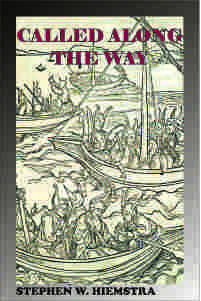 Two are better than one, because they have a good reward for their toil.
Two are better than one, because they have a good reward for their toil.
For if they fall, one will lift up his fellow. But woe to him who is alone
when he falls and has not another to lift him up! (Eccl 4:9-10)
Phillip
By Stephen W. Hiemstra
In the second grade Mrs. S. quickly learned that asking me to stand in front of the class
was not a discipline strategy that worked well with me—I had too much fun!
So I went back to standing face in the corner
And getting wacked on open hands with a ruler.
Still, it was an interesting year.
At one point my class—the whole school—was dismissed to watch Astronaut John Glenn fly overhead.
His space capsule looked like a daytime star racing across the sky—
I don’t remember if we saw him fly around the earth all three times.
It was exciting—how could I forget?
Second grade was the year that I met Phillip.
Phillip was special because he lived on a farm down Good Luck road
Past all the new neighborhoods that had been built.
My mom used to drop me off afternoons or on the weekend.
The farm wasn’t much—just an old farmhouse, a garage, a shed and a lot of fields.
They didn’t have any animals or machinery—
no one seemed to care for the hay fields that it had
But the gravel road out front was just like Iowa.
And we wandered together around those fields shooting his BB gun and just being boys.
Phillip said that I was special because I did not run wild
And shoot BBs in the air like the other boys.
But I never saw all that.
Further down the road in the woods someone built a plywood treehouse
It seemed out of place and whoever built it left a lot of flares behind
Which we confused with dynamite.
It was scary.
Phillip’s mother didn’t mind us—she always made lunch
while his dad mostly sat at the table working on papers.
Phillip and I were friends until the fourth grade
When his father put a 22 caliber rifle to his head and shot himself.
Then,
Phillip and his mother moved to Bethesda.
I missed Phillip.
After a bit, I looked him up in the phone book
and called a bunch of folks until I got his number.
We talked a bit, but never spoke again.


January 26, 2016
Swindol Introduces an Authentic Abraham
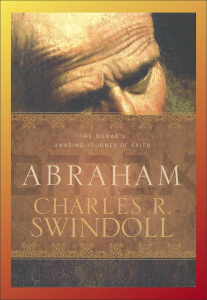 Charles R. Swindoll. 2014. Abraham: One Nomad’s Amazing Journey of Faith. Carol Stream: Tyndale House Publications, Inc.
Charles R. Swindoll. 2014. Abraham: One Nomad’s Amazing Journey of Faith. Carol Stream: Tyndale House Publications, Inc.
Review by Stephen W. Hiemstra
Authenticity. I have always been drawn to people who ooze authenticity.
In grade school, a favorite aunt gave me a biography of Winston Churchill—an authentic war hero and statesman (Malkus 1957). I was hooked. Reading biographies and listening carefully to the life-stories of the people around me became a life-long passion. Author John Savage (1996, 82) calls stories from the past with current meaning rehearsal stories. In more recent years, I have been repeatedly drawn to the story of Abraham—a biblical story of an authentic man of faith who continues to inspire me. So when the leader of my church’s men’s group gave me a copy of Charles Swindoll’s Abraham, I knew it would be a page turner.
Swindoll sees 4 reasons why biographies are worth studying:
A good biography translates truth into life.
A good biography creates a closer kinship with people we have admired from a distance.
A good biography offers stability when we go through similar experiences.
A good biography helps us maintain a divine perspective on life (viii-x).
This idea of a rehearsal story is actually part of the Lord’s Prayer: we pray that “your will be done, on earth as it is in heaven” (Matt. 6:10). In other words, we take the biblical pattern, such as seen in the life of Abraham (a shadow of heaven), as a pattern for our own lives (here on earth). Are you excited yet?
Swindoll sees Abraham as interesting because:
Out of this mass of theologically aimless humanity, one man emerged who began to proclaim what we might call “radical theism.” The man we know today as Abraham not only claimed that one true Creator existed and that all other gods did not, but he also stacked his entire life on this belief (xi).
In other words, Abraham oozed authenticity.
Abraham’s authenticity was apparently attracted a loyal following who were not, per se, his slaves or relatives. Swindol writes:
Abram attracted a large number of loyal followers because he was a wealthy, influential man. His household grew in numbers because people saw how his community enjoyed provision and protection. (43)
Today we might describe this phenomena as an entourage—people just wanted to be with Abraham. Abraham’s faith was part of the attraction.
Part of Abraham’s attraction was that he was a fearless and cunning warrior. Swindol writes:
Genesis 14 would make an exciting action movie. It contains all the necessary elements of a great story. A riveting plot. Villains. A crisis. A hero. Strategy, swordplay, and acts of daring. A surprising twist and—just as critical to good storytelling—meaningful character development. (42)
Abraham defeats the superpowers of his day at their own game in spite of being vastly outnumbered and he rescues his nephew, Lot, from a life of slavery. Having beaten the superpowers, Abraham refuses to grab Canaan (including Sodom and Gomorrah) by force, preferring to wait on God’s timing to claim God’s promise of land in Canaan.
Charles Swindol was senior pastor of churches in Texas, Massachusetts, and California. He is the former president and chancellor of Dallas Theological Seminary and has led a radio ministry, Insight for Living, for many years. Swindol’s writes a comprehensive account of Abraham’s life and spiritual journey in 20 chapters.
Based on Abraham’s life, Swindol offers this closing advice:
Wherever God leads, follow.
Whatever God promises, believe.
Whenever God tests, trust.
However God blesses, share (260).
May this book bless you and may you, in turn, bless others.
References
Malkus, Alida Sim. 1957. The Story of Winston Churchill. New York: Grosset and Dunlap.
Savage, John. 1996. Listening & Caring Skills: A Guide for Groups and Leaders. Nashville: Abingdon Press.
Review: Savage Teaches Listening; Hears Unheard Stories (http://wp.me/p3Xeut-4e)
Interestingly, later in Genesis 18:22-33 he argues (prays) that God spare Sodom and Gomorrah from destruction for the sake of the righteous people found there, including his nephew.
This is a paraphrase of Genesis 12:2-3 which I have used in signing my own book, A Christian Guide to Spirituality (T2Pneuma.com).


January 24, 2016
13. Prayers of a Life in Tension by Stephen W. Hiemstra
Thank you for the hope that comes in the midst of life and death.
Be especially present with those that grieve—
Grieve over the loss of a loved one,
Grieve over a life not lived according to plan,
Grieve over sin and brokeness and shame.
Show us the road to recovery, wholeness, and restoration.
Show us the plans that you have laid out for us,
Plans for welfare, not evil, for a future, and a hope in you.
Grant us godly grief that produces repentance and redemption and new life in joy.
In the power of your Holy Spirit, wipe away our tears
So that we might behold the Father.
In Jesus’ name, amen.


January 22, 2016
The Farm
 So then you are no longer strangers and aliens,
So then you are no longer strangers and aliens,
but you are fellow citizens with the saints
and members of the household of God
(Eph 2:19)
The Farm
By Stephen W. Hiemstra
The farm was a home.
Neighbors cared. Family was near. The church was always open.
People knew you and you knew them.
Small town life was available, but not too available.
The farm was more than a farm.
It was a safe place where plants and livestock grew
From spring into summer into fall
And winter was a time to rest and prepare for a new season.
Life was regular and predictable and people enjoyed each other’s company.
When I was young, we moved around.
My father was first a student and then an Air Force officer.
We lived in different places.
Home was where you hung your hat.
The farm grew from a place to a destination.
In the city, some neighbors knew you.
Sometimes family visited.
Sometimes churches were open.
Often we knew just a few people, mostly from church.
City life was ever-present, but never really present.
Home became illusive.


January 19, 2016
Lupton Presents Type in a Whole New Light
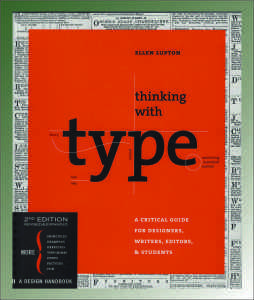 Ellen Lupton. 2010. Thinking with Type: A Critical Guide for Designers, Writers, Editors, and Students. New York: Princeton Architectural Press.
Ellen Lupton. 2010. Thinking with Type: A Critical Guide for Designers, Writers, Editors, and Students. New York: Princeton Architectural Press.
Review by Stephen W. Hiemstra
Often when I talk to friends about my publishing, conversations are short. People get the idea of writing and authorship; they generally draw a blank when it comes to publishing. In particular, the idea that a book needs to be designed seems almost mystical. So my delight in finding a new title focused on identifying and using type (or fonts) has been hard to explain…It is kind of like asking a city kid where food comes from—well duh, it comes from the grocery store!
Ellen Lupton, author of Thinking with Type, has clearly traveled this route. She searched for a suitable textbook on using type for her class at the Maryland Institute College of Art, but resolved that she needed to write the book herself (7).
The first thing to notice about Thinking with Type is that the book is rather heavy (1.4 pounds) and a bit more square (7” x 8.5”) than the more typical paperback (9” x 6”). Thinking with Type has a lot of glossy photographs to illustrate the points being made. Needless to say, it is a visual delight.
The format of the book serves its purpose well. Lupton writes:
This book is about thinking with typography—in the end, the emphasis falls on “with”. Typography is a tool for doing things with: shaping content, giving language a physical body, enabling the social flow of messages (8).
If the medium is the message, as Marshall McLuhan famously remarked, then the primary medium of a book is type. Good books sport good design and the designer needs to know the role played by type. A good choice of type requires some knowledge of how it came to be, the associations it brings to bear, and the way it relates to the subject of the book. Are you interested yet?
Lupton organizes her presentation into three categories: letter, text, and grid (or spatial organization).
Letters. Early text was significantly influenced by the human body and calligraphy. Johannes Gutenberg, for example, published the first movable type in a Bible in which he attempted to emulate Bibles that were previously written exclusively by hand and included copious illustrations. Movable type caught on in Germany, but not in China where it was invented, because the Latin alphabet was phonetic and could be illustrated with relatively few letters, unlike Mandarin which pictured words rather than sounding them out. Mandarin had too many letter forms to be easily automated with those early printing presses (13).
Text. A text, Lupton reminds us, is: an ongoing sequence of words distinct from shorter headlines or captions (87). Debates about a book, which requires an author, as opposed to “text” are everywhere in the postmodern period when authors, like Jacques Derrida (91), question to the need for an authority figure in charge of producing a text. Lupton enters this debate, in part, by elegantly illustrating alternatives to simple text.
For example, is a webpage with many links embedded a book? Most people would say no. Why? Who, for example, is the author? Is it the programmer, the web-designer, the illustrator, or the copy writer? Clearly, questions relating to the formatting of text go way beyond the decision to right, left, or center justify.
Grid. Of the three sections (letters, text, and grid), grid is probably the least familiar. Lupton defines grid in this way:
A grid breaks space or time into regular units [all small caps]. A grid can be simple or complex, specific or generic, tightly defined or loosely interpreted. Typographical grids are all about control (151).
Here Lupton’s use of illustrations is amazing. The number of choices in organizing text is amazing because most of the options are not at all obvious. Those of us who use study bibles, for example, are used to seeing footnotes and other annotations down the center of the page, but this is seldom done anywhere else—most people are accustomed to footnotes at the bottom of the page.
Repeatedly, Lupton draws on magazine grid to illustrate novel grids that highlight different dimensions of the text. The influence of graphical artists on how we perceive text is striking and at times even subversive. Presentation matters and significantly influences text interpretation. Think , for example, of the use of red letters in some Bibles—the original Greek was all caps without any punctuation and no red letters!
Ellen Lupton’s Thinking with Type is a fun and informative book. For those of you who don’t care about publishing and have no interest in design might think of it as a conversation starter. It is that interesting.
https://en.wikipedia.org/wiki/The_medium_is_the_message
Of course, I gravitated to the Biblia Polyglotta (154-155) which in 1568 offered the reader the Bible in Hebrew, Latin, Aramaic, Syriac, and Greek. Today, a good program could organize such a text in minutes, but in 1568 all that was done by hand suggesting that proof-readers really did need some language skills.


January 17, 2016
12. Prayers of a Life in Tension by Stephen W. Hiemstra
Be especially near me this morning.
Blott out my guilt; hide my shame; cover up my sin.
Share an intimate moment with me though I be unworthy.
Remind me of better times.
Grant me a new day in the sunshine of your mercy.
A day when I could loose myself in your love
And extend your love to those around me without a thought.
Open the bridge over the gaps that separate us,
The gaps of time and holiness and power
That I might spend more time with those around me,
Might share in your holy affections,
Might overcome my own weaknesses and bitterness.
Through the power of your Holy Spirit.
In Jesus’ name, Amen.


January 16, 2016
Cuaresma Venta, Lenten Sale
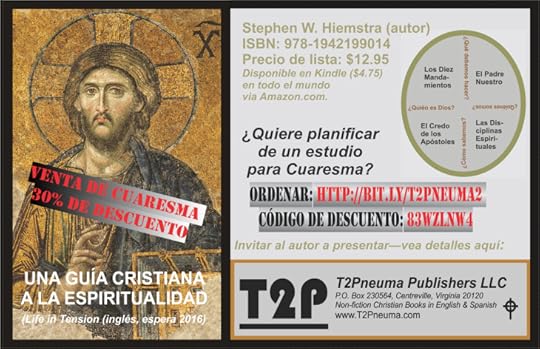
Una Guia Cristina a la Espiritualidad cubierta
Lent is a reflective time when we anticipate the coming of Easter. For this reason, I invite you to deepen your faith through a Lenten study of A Christian Guide to Spirituality which is now also available in Spanish.
A Christian Guide to Spirituality is organized into 50 daily devotions. Each has a theme, a reflection, and a prayer. Questions also follow to deepen your understanding.
To order with a 30 percent discount from the list price, go to:http://BIT.LY/T2PNEUMA (English) or http://BIT.LY/T2PNEUMA2 (Spanish) and enter discount code: 83WZLNW4.
Thank you for your support!
Stephen
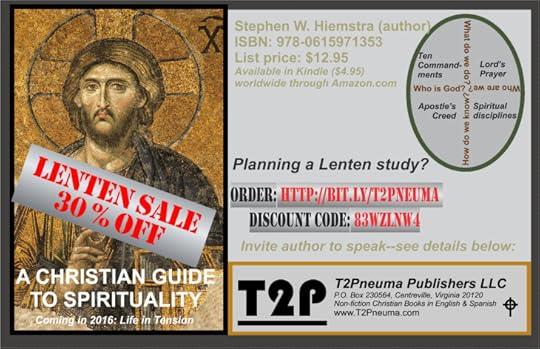
Cover, A Christian Guide to Spirituality


January 15, 2016
Music Lessons
 For if you forgive others their trespasses,
For if you forgive others their trespasses,
your heavenly Father will also forgive you . . .
(Matt 6:14)
Music Lessons
By Stephen W. Hiemstra
My father and mother met during a couples skate in August 1951
at an roller-skating rink in Guelph, Ontario where she grew up.
At the time, mom worked as a singer with an orchestra
and she played popular music on the piano.
My piano lessons came about more by accident.
One morning as my dad was backing out of the driveway on Trexler Road,
He ran into one of the neighbors—a Mrs. C who was a piano teacher.
I still remember the tail lights shattered and scattered all over the road.
Not long thereafter, my sister, Diane, and I began lessons with Mrs. C.
At the time I was in fourth grade.
Mom used to play hymns and Broadway musical hits in the evening
On the old, second-hand piano that we kept in the recreation room.
Hymns like How Great Thou Art that George Beverly Shea used to sing
Hits like One Enchanted Evening from the Broadway musical, South Pacific.
I was never that good.
I would have loved to play piano and lead folks in signing around the piano
Like they did in movies like It’s a Wonderful Life.
But instead I practiced half an hour a day,
And fretted about not seeing a favorite television show.
Later when I took up trombone lessons, I gave up the piano
Until about 20 years later when my kids were born.
Still, I remember Mrs. C and her accident . . .





